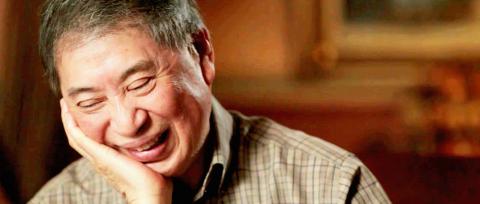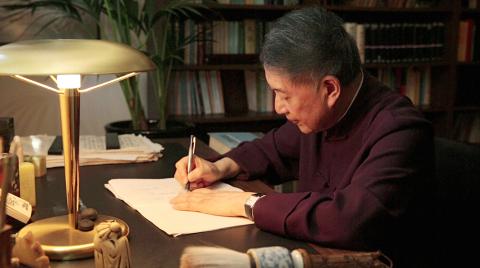Kenneth Hsien-yung Pai (白先勇) is a man of many achievements. The 78-year-old is considered one of the first writers to introduce Western-style modernism to Chinese-language literature. His novel, Crystal Boys (孽子), first serialized in 1977, is regarded as a seminal work of gay literature in the local scene. In later years, the author has also become a key figure in reviving kunqu (崑曲), one of the oldest living operatic traditions of China.
Director Teng Yung-hsing (鄧勇星), tasked with making a documentary about the literary heavyweight, delved into Pai’s personal and emotional life.
“Behind all those words, there is a world. And inside the world, there is a person hiding,” Teng says.

Photo courtesy of Fisfisa Media
The resulting film, Hsien-Yung Pai (奼紫嫣紅開遍), is part of the second series of a film project titled The Inspired Island: Series of Eminent Writers From Taiwan (他們在島嶼寫作—文學大師系列電影), which, initiated in 2008, has now expanded to include Hong Kong writers. In this installment, eight directors document the lives and work of seven writers, including Taiwanese poet Ya Shian (?弦) and Hong Kong writer Xi Xi (西西), whose work is widely-read in Taiwan.
Through Teng’s lens, Pai is not only revealed as an eloquent man of literature, but also one who is forever in quest of a home through his work.
SENSE OF BELONGING

Photo courtesy of Fisfisa Media
Born in 1937 in Guilin, China, Pai grew up during the Second Sino-Japanese War and subsequent Chinese Civil War. His father, Pai Chung-hsi (白崇禧), was a general under Chiang Kai-shek’s (蔣介石) Chinese Nationalist Party (KMT) regime. In 1952, the family resettled in Taipei after the KMT lost the war to the communists.
In 1960, the then-aspiring writer collaborated with several classmates at National Taiwan University to launch Modern Literature (現代文學) magazine, which served as a platform for young writers in the 60s and 70s. The work of many prominent literary figures appeared in the magazine, such as Chen Ying-zhen (陳映真) and Huang Chun-ming (黃春明).
In 1963, Pai traveled to the US to study literature. He later became a professor at the University of California at Santa Barbara, where he has resided ever since.
The diasporic experience of his and his parents’ generation are a recurrent motif in the writer’s novels.
Taipei People (台北人), for example, is a collection of 14 short stories published in 1971 about people who fled to Taiwan from China after 1949. A feeling of loss and nostalgia permeates the work.
“Each story seems to tell a personal destiny, but it is also part of a collective fate in a turbulent era. All [the characters] are looking for a sense of belonging. It is not necessarily a house or a place, but a spiritual home,” Pai says of Taipei People in the film.
In addition, Pai’s homosexuality during a time when the LGBT community had to hide underground also led to works that reflect the sense of being an outsider, rootless and unwanted. Crystal Boys, published as a novel in 1983, is a pioneering book that explores the gay culture in Taiwanese society through the eyes of Lee Ching, a young runaway living in 1970s Taipei.
“[The characters] are ostracized, expelled from the patriarchal society. They are orphans trying to find a place in the world, spiritual or carnal,” Pai says.
CHINESE CULTURE
Home, to Pai, is not somewhere in China, Taiwan or the US.
“Once I was asked where my homeland was. I couldn’t answer it right away. It is not geographical. It is traditional Chinese culture,” the author says.
It’s this sentiment that drives Pai to apply his talents to the revival of kunqu. In 2004, Pai’s highly acclaimed version of The Peony Pavilion (牡丹亭) premiered at the National Theater in Taipei, sporting a youthful cast and a fresh aesthetic that has generated massive interest among a new generation of audiences.
In the film, Pai also discusses his late father, who died in 1966, whose story is featured in two books which he co-wrote with historian Liao Yen-po (廖彥博).
Teng says these ventures are all part of Pai’s lifelong quest for a sense of belonging.
“Whether it is his father or kunqu, they are like doors through which Pai tries to return to a place in his heart, an unnameable something that is intensely missing,” the director says.
The series is showing at theaters in Taipei, Taichung, Tainan and Kaohsiung. Screenings are mostly in Mandarin and Cantonese with Chinese subtitles. For more information, visit www.poemmovie.com.tw/island2 and www.facebook.com/poemmovie.

June 2 to June 8 Taiwan’s woodcutters believe that if they see even one speck of red in their cooked rice, no matter how small, an accident is going to happen. Peng Chin-tian (彭錦田) swears that this has proven to be true at every stop during his decades-long career in the logging industry. Along with mining, timber harvesting was once considered the most dangerous profession in Taiwan. Not only were mishaps common during all stages of processing, it was difficult to transport the injured to get medical treatment. Many died during the arduous journey. Peng recounts some of his accidents in

“Why does Taiwan identity decline?”a group of researchers lead by University of Nevada political scientist Austin Wang (王宏恩) asked in a recent paper. After all, it is not difficult to explain the rise in Taiwanese identity after the early 1990s. But no model predicted its decline during the 2016-2018 period, they say. After testing various alternative explanations, Wang et al argue that the fall-off in Taiwanese identity during that period is related to voter hedging based on the performance of the Democratic Progressive Party (DPP). Since the DPP is perceived as the guardian of Taiwan identity, when it performs well,

A short walk beneath the dense Amazon canopy, the forest abruptly opens up. Fallen logs are rotting, the trees grow sparser and the temperature rises in places sunlight hits the ground. This is what 24 years of severe drought looks like in the world’s largest rainforest. But this patch of degraded forest, about the size of a soccer field, is a scientific experiment. Launched in 2000 by Brazilian and British scientists, Esecaflor — short for “Forest Drought Study Project” in Portuguese — set out to simulate a future in which the changing climate could deplete the Amazon of rainfall. It is

Artifacts found at archeological sites in France and Spain along the Bay of Biscay shoreline show that humans have been crafting tools from whale bones since more than 20,000 years ago, illustrating anew the resourcefulness of prehistoric people. The tools, primarily hunting implements such as projectile points, were fashioned from the bones of at least five species of large whales, the researchers said. Bones from sperm whales were the most abundant, followed by fin whales, gray whales, right or bowhead whales — two species indistinguishable with the analytical method used in the study — and blue whales. With seafaring capabilities by humans